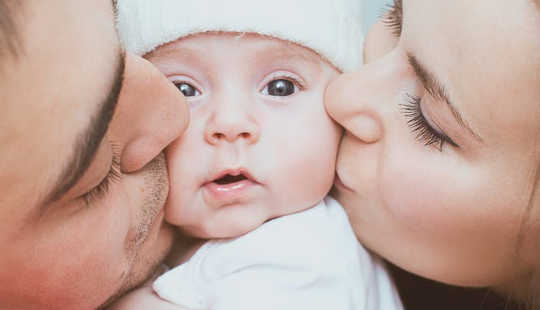 Feeling secure? Tania Kolinko/Shutterstock
Feeling secure? Tania Kolinko/Shutterstock
If you’ve suffered from anxiety, depression or relationship problems, a psychological theory called “attachment theory” can help you get to the root cause of your difficulties and give you a greater understanding of what’s going on.
Attachment theory was developed by British psychiatrist John Bowlby in the 1960s. The theory explains how our brains are programmed to help us survive and thrive in the environment we are born into.
Our self-esteem, ability to control our emotions and the quality of our relationships are all affected by our attachment style. We’ve known for over 50 years that attachment styles can predict and explain children’s behaviour. More recent research has shown that attachment styles also continue to affect our behaviour in adulthood.
Four attachment styles
Infants develop one of four main attachment styles in response to the care they receive from their parents or other carers during infancy. Carers who are sensitive to children’s needs foster a “secure attachment style”. Carers who become distressed and retreat when their children are upset create an “avoidant attachment style”. Carers who respond sensitively but are often distracted from their caregiving create an “anxious attachment style”. And carers who harm their children through neglect or abuse, create a “disorganised attachment style”.
As children, we develop an attachment style that keeps us safe by programming us to behave in certain ways towards our carer when we are anxious or afraid. These behaviours elicit a response from our carer that, ideally, should be protective.
Our brains are programmed through the relationship with our main carer. During this process, we learn to recognise and control our emotions and we create a “template” that guides our social interactions and informs us whether and how we are valued by other people.
Faulty template
Someone with a secure attachment style feels valued by others, can rely on them to be helpful and is able to control their emotions. At the other end of the spectrum, someone with a disorganised style does not feel valued by others, easily loses control of their emotions and resorts to manipulative behaviour to coerce others into providing help.
When we feel anxious or fearful, the template created during infancy tells us how to respond. The world we live in now is often different from the one we were born into when our attachment style was forming, so our response to life’s events may be unsuitable. For example, someone with an anxious attachment style who constantly talks about their latest problem may lose friends who become frustrated by their inability to help.
Research shows that attachment style affects our performance in many areas of life, including physical and mental health, finding a compatible romantic partner, and our behaviour in family, social and work contexts. Attachment style even affects the type of religious belief we hold, our relationships with pets and whether our home feels like a haven.
Once you know your own attachment style – which you can easily discover by completing an online survey – you will be able to predict what your response is likely to be in different circumstances. For example, if you have an avoidant attachment style, you fear rejection and may decide not to go for a promotion at work.
When you realise that your fear of rejection is caused by your carer’s own difficulties when you were little, it may help you change your own mindset. Taking such positive steps can help you develop a more secure attachment style. So take steps to find out what your attachment style is – it can only be of benefit.![]()
About The Author
Helen Dent, Emeritus Professor of Clinical and Forensic Psychology, Staffordshire University
This article is republished from The Conversation under a Creative Commons license. Read the original article.
Related Books
at InnerSelf Market and Amazon


























